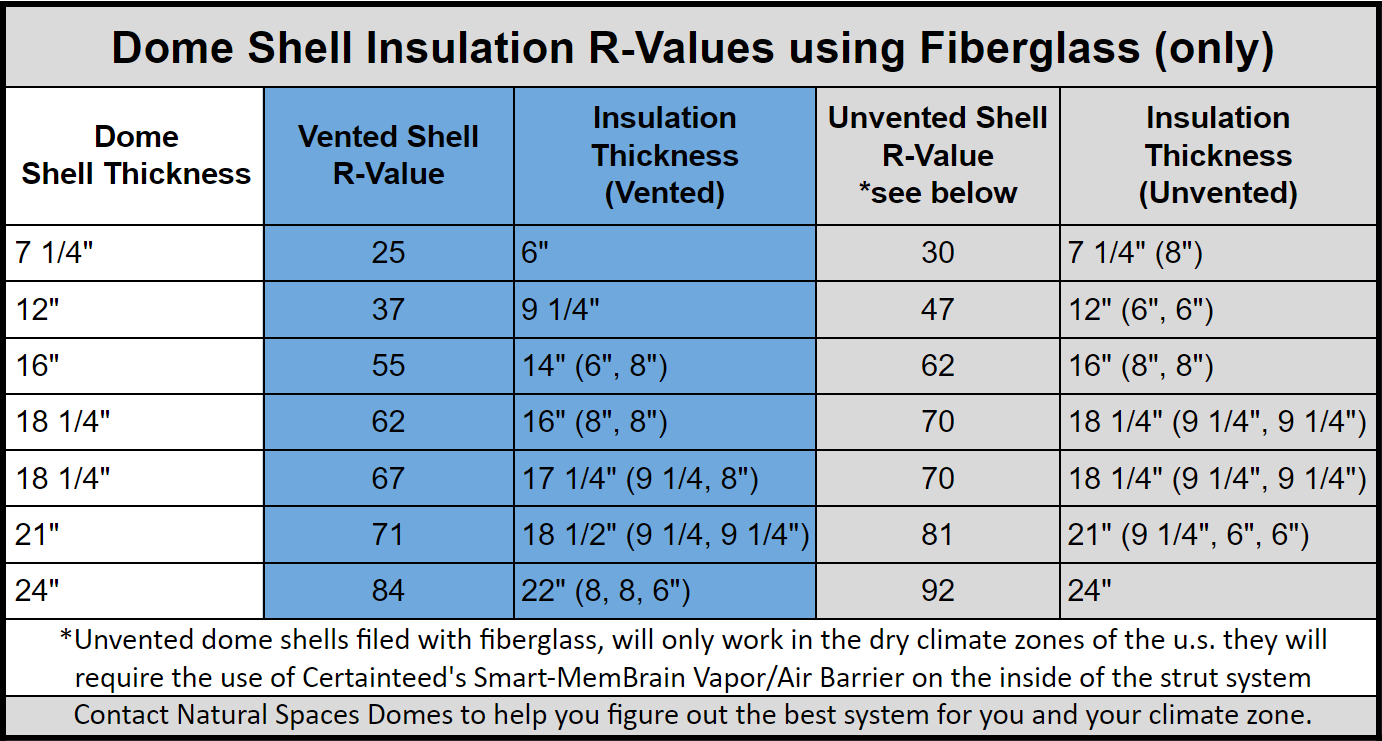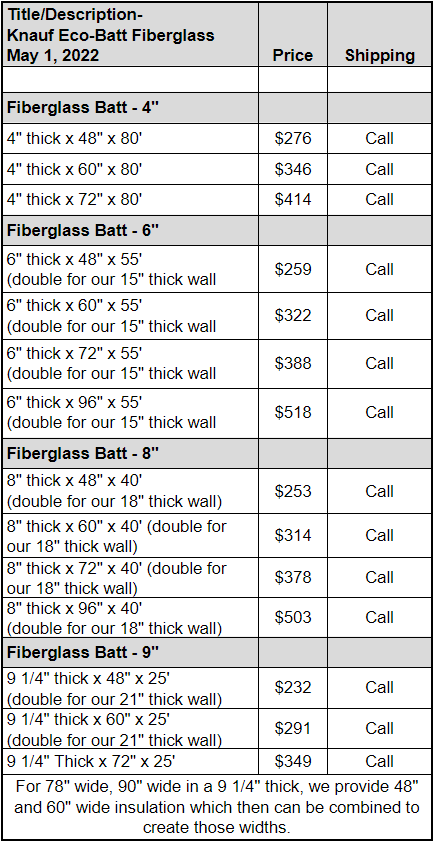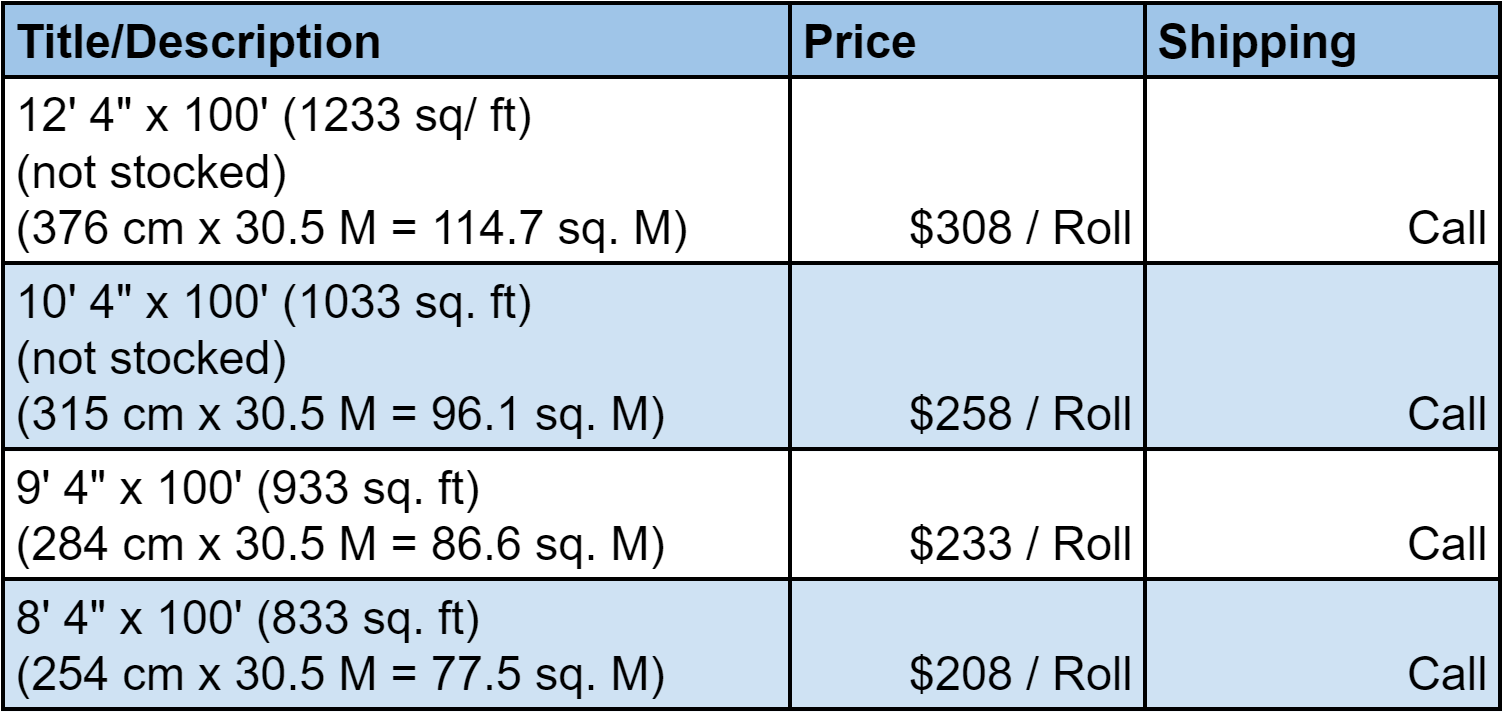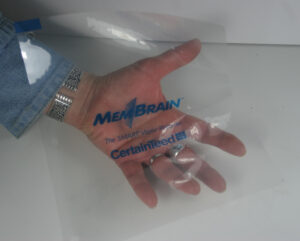The Natural Spaces Super-Wal dome system was originally designed as an ultra-super-insulated wall for using fiberglass batt insulation. Besides our standard 2 x 8 Dome Shell, we offer dome shell thicknesses of 10 3/4″, 12″, 15″, 18 1/4″, 21″ and 24″. These provide R-values up to incredible levels of 92 (see chart below).
Natural Spaces Domes is now using the next generation of Sustainable Insulation…
EcoBatt™
Think of it as green, only browner
Knauf EcoBatt™ Insulation doesn’t look like any insulation you’ve ever seen, but that’s because its natural brown color represents a level of sustainability never before achieved.
The color comes from ECOSE™ Technology , a revolutionary, new sustainable binder born from five years of intensive research. Made from rapidly renewable organic materials rather than petroleum-based chemicals commonly used in other insulation products, ECOSE Technology reduces binder embodied energy by up to 70% and does not contain phenol, formaldehyde, acrylics or artificial colors used to make traditional fiberglass insulation.
, a revolutionary, new sustainable binder born from five years of intensive research. Made from rapidly renewable organic materials rather than petroleum-based chemicals commonly used in other insulation products, ECOSE Technology reduces binder embodied energy by up to 70% and does not contain phenol, formaldehyde, acrylics or artificial colors used to make traditional fiberglass insulation.
EcoBatt Insulation combines sand, one of the world’s most abundant and renewable resources, post-consumer recycled bottle glass and ECOSE Technology to create the next generation of sustainable insulation…naturally from Knauf. EcoBatt is made from 61% recycled glass – 27% post consumer, 34% pre-consumer.
EcoBatt does not support microbial growth or attract insects or vermin. In addition to being classified as mold resistant by GREENGUARD, EcoBatt Insulation has passed exhaustive entomological testing at leading institutions in the US and UK.
It is also classified as noncombustible with a flame spread under 25.
For more information on EcoBatt™,
Click here to go to Knauf Insulation’s web site.
If someone tells you there is a “point of diminishing returns” in relation to R-values, they haven’t looked at today’s and tomorrow’s energy cost. When compared using the same R-value, fiberglass batts are 1/3 the cost of rigid polystyrene foam insulation or Icynene insulation and 1/5 the cost of sprayed-in-place urethane foam. Check with us for a cost-saving comparison and the most up to date environmental info. Our installation methods and our use of industrial-grade fiberglass reduce air infiltration dramatically, allowing an honest comparison of R-values with other insulation types.

Some dome companies use an R-35 insulation value using 2×6 construction and fiberglass. You would have to use urethane foam to get that R-value. Building codes allow a maximum R-value of 6.25/inch for figuring urethane foam-insulating values. Some of the new spray foams are rated at R-7 per inch.
Other companies also say that there are vastly diminishing returns beyond a certain R-value. In the 2021 IRC code, the minimum ceiling R-value for the northern tier of the U.S. is R-60. 35 years ago these same building codes were suggesting an R-19 ceiling. Starting in the early 2000’s, the IRC (International Building Code) required an R-49 minimum, that being the worst house you could build, Natural Spaces Domes has been using an R-60 as our suggested minimum. How will it change in the future? Why build a dome home with 2×6’s or 2×8’s that starts out 35 years behind the times?! Natural Spaces Domes now suggests a minimum R-72 for northern and southern areas of the U.S.

Our knauf wide batt fiberglass insulation is very stiff and dense, allowing the 6′ high one-piece triangle to stand straight on its 8″ edge as shown above.
You actually pay substantially less for a Natural Space dome with an R-72 value than you do for the competition’s dome with an R-30! We offer industrial type fiberglass batts in various thicknesses of 4″, 6”, 8” and 9 1/4”. We put in 2 layers creating 12”, 16” and 18” thicknesses of insulation. We are also suggesting a hybrid of urethane foam and fiberglass batts to eliminate air infiltration.
Not readily available in the residential market, we offer 48″, 60”, 72″, and 96″ wide rolls of insulation. This eliminates the joint lines occurring if you were to use 16′ or 24″ wide batts. It also cuts down the installation time considerably. This seamless one-piece triangle insulation works extremely well in our Natural Spaces dome because we do not require all of the internal studs all of the other dome systems need. Our triangle spaces are wide open, just waiting for a full-size fiberglass insulation triangle. It is also non-combustible, formaldehyde-free, no phenolic resins and helps reduce sound transmission through the dome shell.
The insulation is cut on-site using full-size templates. We include a 6” knife, 2 filter masks and safety glasses.
We also are including the full-size plywood triangle templates for each triangle in your dome (with the purchase of EcoBatt Fiberglass Insulation).

Fiberglass batt insulation, we have found, is the safest and most economical type for our domes.
The standard insulation we use is Knauf fiberglass made for the industrial market. The air infiltration is minimal. The R-value chart uses an established value of 3.7/inch. This special insulation will perform at this higher number. The R-value numbers used in the chart include the entire wall/roof assembly of materials, (exterior panel, air space, interior panel, etc.).


Prices and Ordering May 1st, 2022
Fiberglass Insulation for the Dome Exterior Triangles
Exact quantities needed for each dome are based on how many extension openings and skylights are in your dome.
(No separate shipping cost when ordered as part of the dome shell package and shipped in the same truck. Shipping costs vary with distance to the site, so please call for an accurate quote or to order.)

Insulation – Super-Wal Strut Fillers (Rigid Foam)
Rigid Foam (Non-CFC) pre-cut pieces fit between the 2×8 outer strut and 2×4 inner strut to create a flat edge for the fiberglass insulation. Helps eliminate wind-wash & air infiltration. Sold in packs of 10.
(No separate shipping cost when ordered as part of the dome shell package)

Insulation – Standoff Spacers (Rigid Foam)
Rigid Foam (Non-CFC) pre-cut pieces to hold insulation in place & maintain air space. Used on the first row of triangles for high & mid-profile domes only. Sold in packs of 10.
(No separate shipping cost when ordered as part of the dome shell package)

3M Construction seaming tape
 This 3M tape is the one to use for sealing all the seams on your vapor barrier. Reduce leakage and achieve energy savings. In Minnesota, state building codes require all seams on vapor barriers to be taped.
This 3M tape is the one to use for sealing all the seams on your vapor barrier. Reduce leakage and achieve energy savings. In Minnesota, state building codes require all seams on vapor barriers to be taped.
High tack adhesive • High UV resistance • Application temperature -10℉ to 185℉ (-23℃ to 85℃)
Independent tests by the National Association of Homebuilders show a 30% increase in performance when exterior house wrap seams are sealed. Used on the interior vapor barrier, taping the seams would almost eliminate any air infiltration, as proven by blower door tests on our Bear Creek Dome. (No separate shipping cost when ordered as part of the dome shell package)
MemBrain™—The Smart Vapor Retarder.
Especially in climates with extreme seasonal fluctuations in climate and humidity, there’s no foolproof way to keep moisture from getting into a wall. But now there’s a revolutionary way to help get it out.
Designed to be applied over unfaced fiberglass insulation only, MemBrain looks similar to typical polyethylene sheeting but is actually a polyamide-based material. But what makes MemBrain unique is its ability to adapt its permeability depending on climatic conditions.
With a high resistance to water vapor in winter or low humidity, MemBrain behaves like a moisture vapor retarder such as poly sheeting. When the relative humidity increases, its water vapor permeability increases dramatically. This allows water vapor to escape the wall cavity easily when the humidity is high.
MemBrain is recommended only for heating climates needing some cooling in the summer – The middle of the USA from midwest to the east coast in IRC zones #4A and #5A (mixed-humid climate zones). In IRC #3A zone (mixed warm-moist), we may recommend a non-vented roof so we need to look at individual sites and building materials. In IRC zone #6A (very cold-moist), if you plan to use a lot of air conditioning during the summer, we would use this product. We are also using it in the high desert climate zones in Utah and Nevada when we do a non-vented dome shell using blown-in fiberglass that fills our Super-Wal cavity. It is not suitable for areas or buildings with very high, constant indoor humidity levels above 45%.
Click here for more information on MemBrain™
Standard rolls are :



